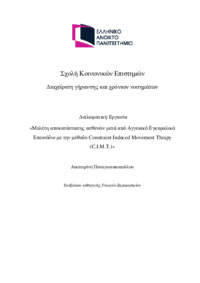- MSc thesis
- Διαχείριση Γήρανσης και Χρόνιων Νοσημάτων (ΓΧΝ)
- 30 June 2023
- Ελληνικά
- 36
- Γεωργία Ξηρομερήσιου
- ΑΥΓΟΥΣΤΙΝΟΣ ΔΗΜΗΤΡΑΣ
- Αγγειακό εγκεφαλικό επεισόδιο, άνω άκρο, νευροπλαστικότητα, learned non-use, κινητική μάθηση, Constrain-induced movement therapy.
- Νευρολογικές, ψυχιατρικές παθήσεις / ΓΧΝ20
- 59
- Απεικόνιση του τρόπου ανάπτυξης του μηχανισμού Learnen Non-Use, του τρόπου αναστροφής του μηχανισμού LNU μέσω της CIMT. και εικόνα πρακτικής προσανατολισμένης στην εργασία με το παρετικό άκρο σε μια συνεδρία .
-
-
Το Αγγειακό Εγκεφαλικό Επεισόδιο είναι ένα κοινό και πολύ σοβαρό παγκόσμιο πρόβλημα της υγειονομικής περίθαλψης και η αποκατάσταση αποτελεί σημαντικό μέρος της φροντίδας των ασθενών. Στοιχεία από όλο τον κόσμο δείχνουν την μέγιστη σημασία της αντιμετώπισης των κινητικών ελλειμμάτων, καθώς ένα μεγάλο ποσοστό των επειζώντων ενός Α.Ε.Ε. εμφανίζει ημιπληγία στο άνω άκρο, γεγονός που οδηγεί σε σημαντικούς περιορισμούς στην ανεξαρτησία και την ποιότητας ζωής των ασθενών. ένα μέρος του κινητικού ελλείμματος που προκύπτει από βλάβη στο νευρικό σύστημα δεν είναι αποτέλεσμα της βλάβης αυτής καθεαυτής, αλλά ενός μαθησιακού φαινομένου που προέρχεται από τη βλάβη, αλλά του οποίου ο πυρήνας είναι η μαθημένη καταστολή της κίνησης. Μια νέα θεραπευτική παρέμβαση, που έρχεται σε μεγάλη αντίθεση με τις παραδοσιακές τεχνικές κινητκής αποκατάστασης και η οποία βασίζεται σε εμπειρικά τεκμηριωμένη θεωρία ενσωματώνοντας την κινητική μάθηση και τις νευροβιολογικές διεργασίες μετά από Α.Ε.Ε., είναι η θεραπεία με περιορισμούς
-
The Cerebral Vascular Accident (CVA) is a common and serious global healthcare problem, and rehabilitation plays a significant role in patient care. Data from around the world demonstrate the utmost importance of addressing motor deficits, as a large percentage of CVA survivors experience hemiplegia in the upper extremity, which leads to significant limitations in independence and quality of life. Part of the motor impairment resulting from damage to the nervous system is not a direct consequence of the damage itself but rather a learned non-use phenomenon. A new therapeutic intervention that contradicts traditional techniques of motor restoration, based on empirically supported theories that incorporate motor learning and neurobiological processes after CVA, is Constraint-Induced Movement Therapy (CIMT). The positive results of CIMT are believed to be attributed to two mechanisms: overcoming the learned non-use phenomenon and facilitating cortical reorganization in the human brain. This thesis will reference multiple studies demonstrating functional improvements in adults with hemiplegia after CVA following the application of CIMT, with results that are beneficial for patient independence and overall quality of life. Despite the positive research findings, CIMT is considered a highly demanding intervention and has not been widely implemented in routine clinical practice. For these reasons, there is a need to modify the treatment program and explore complementary interventions in the application of CIMT to promote neuroplasticity and facilitate current therapeutic approaches. A crucial step for the future of neurorestoration is studying combinations of various interventions, whether novel or traditional, with the CIMT technique, as well as conducting research to identify the optimal components for intervention and exploring different protocols for modified CIMT application.
-
- Hellenic Open University
- Attribution-NonCommercial-NoDerivatives 4.0 Διεθνές
Μελέτη αποκατάστασης ασθενών μετά από Αγγειακό Εγκεφαλικό Επεισόδιο με την μέθοδο Constraint Induced Movement Thrapy (C.I.M.T.)
Study of rehabilitation of patients after a Vascular Stroke using the Constraint Induced Movement Thrapy (C.I.M.T.) method" (english)
Main Files
 Κύριο μέρος της Διπλωματικής
Κύριο μέρος της Διπλωματικής
Description: «Μελέτη αποκατάστασης ασθενών μετά από Αγγειακό Εγκεφαλικό Επεισόδιο με την μέθοδο Constraint Induced Movement Thrapy (C.I.M.T.)» (1).pdf (pdf) Book Reader
Size: 1.3 MB

